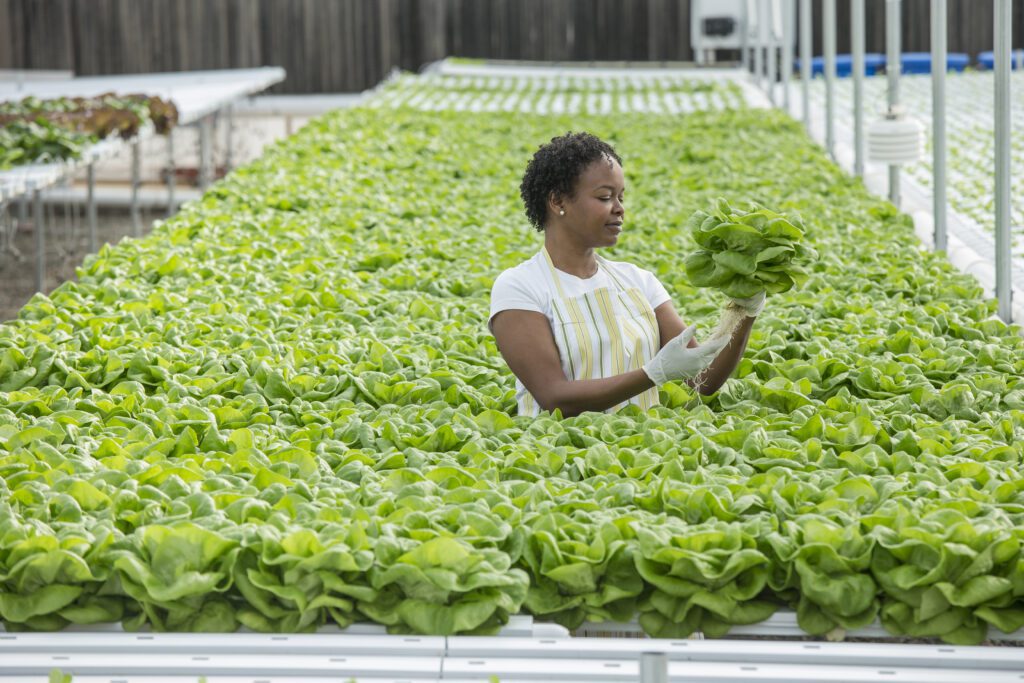Our planet is facing a global food production and distribution system challenge. The UN forecasts a global population increase of nearly 2 billion over the next 30 years. Food production must increase by 70% without impacting the environment.

Consider the example of the nation of Singapore. Given the many competing land needs of the densely populated island nation, only 1% of Singapore’s land is set aside for farming, according to the Singapore Food Agency. Singapore’s agri-food industry will be significantly challenged to uplift its productivity in the coming years. To overcome land and resource constraints, some farmers use indoor multi-story LED lighting and recirculating aquaculture systems to produce 10 to 15 times more than traditional farms.
Transitioning from traditional farming approaches will require novel processes and innovative food-growing technologies. The work to address this challenge has already begun with the emergence of multiple new food cultivation methods. These include:
Indoor Growing
- Indoor growing is also known as controlled environment agriculture. An indoor growing system enables the cultivation of certain crops year-round with a low risk of damage from weather, pests, or diseases.
Vertical farming
- Vertical farming is a subset of indoor growing. Vertical farms reduce the space needed for cropland by using vertically stacked shelves of growing plants that use mainly artificial light in a fully enclosed environment.
Insect farming
- This cultivation process raises and breeds insects as livestock in highly controlled environments. Insect farming produces goods for use as food, feed, or dyes—like silk, honey, or tea, for example.
High automation greenhouses
- These are glass or plastic structures that use mostly natural light. They are highly automated to control temperature, lighting, water flow, airflow, and disease and mold detection with little direct human involvement.
Such approaches lay the groundwork for a new generation of sustainable food systems that can support the growing world population. The field of indoor growing represents a significant step forward in transitioning to more sustainable farming methods.
Indoor growing places crops in a protective building, greenhouse, box, or container and controls the growing environment within the confines of that indoor plant. The light, water, and nutrients provided enable the crop to grow year-round under optimal conditions. Such facilities can produce multiple layers of different crops in the same facility. The protected space limits damage from weather and is much more effective for shielding crops from pests, diseases, and mold. Environmental controls drastically limit losses and reduce the amount of fertilizer and freshwater needed (by virtually eliminating dehydration effects from high temperatures or dry weather, and the water can be more easily recycled).
Since traditional farming grows crops only at the ground layer, vertical farming can multiply production over a given area by 6 to 10 times. Indoor growing also extends growing seasons from only a few months to year-round. A smaller footprint makes it easy to establish vertical farms near major population centers or even on the flat roofs of buildings within metropolitan areas. This drastically reduces the rate of CO2 emissions derived from the typical transportation of agricultural goods across long distances. Since food grown near population centers spends less time in the transportation cycle, spoilage rates are much lower.
Strategies for establishing profitable indoor growing operations
The relatively new indoor growing industry is characterized by a mix of entrepreneurial start-ups, traditional corporate agriculture players, and food retailers. Many organizations seek funding options while others are fine-tuning the profitability of their operations. According to Statista, vertical farming is a €5 Billion global business growing at a rate of 24% per year. However, the business must overcome numerous challenges to grow and drive higher profitability rates. These include:
High-precision energy management
- In an indoor growing environment, energy use can range from 50-70% of the cost of goods sold. Integrating energy and automation can help reduce total expenditure, optimize operations, and reduce the organization’s carbon footprint. The sourcing of energy is also essential. Adding solar panels, wind turbines, and access to renewables-sourced utility energy further minimizes carbon footprint.
Power quality and power conversion efficiency challenges
- Ensuring optimal power quality and conversion efficiency are fundamental to creating sustainable and enhanced growth conditions within indoor growing environments. Integrating Direct Current (DC) Systems approaches will facilitate efficient power distribution. Unlike conventional AC systems, it minimizes losses by employing DC converters that connect LED luminaires directly, bypassing any intermediate conversions. This approach also allows for seamless integration of renewable energy sources, which inherently use DC, thereby leading to enhanced system efficiency, reduced capital expenditure from lesser copper usage, and lower operational costs. This approach adheres to guidelines established by the CurrentOS foundation to ensure system safety and compliance.
Environmental controls
- Vertical farming facility owners must have the means to measure the growing parameters of their crops. Some significant parameters include humidity, temperature, PH balance, yield, and value. Devices such as smart environmental and HVAC systems combined with software make this possible and enable remote monitoring and predictive maintenance. With the right software, easy-to-interpret dashboards can summarize key data elements and generate reports that help optimize growth and crop outputs.
Machines, robotics, and cobots
- Indoor-growing stakeholders are also adopting technological innovations such as robots and cobots. These human/machine collaborative robots can help reduce the repetitive, manual tasks required of human farm workers. They can also quickly adapt to variations in production. They help address physically demanding tasks (like lifting and moving heavy items) and enable rapid production (for fresher goods) while maintaining 24-hour plant operation.
Lighting controls
- Vertical farms use both artificial and natural light. However, using typical LED lighting is costly to purchase upfront and consumes high levels of electricity. Finding the right development partners, forming tight partnerships with energy suppliers, and minimizing energy costs through management tools such as EcoStruxure Microgrids can reduce energy expenses.
Water and nutrient optimization
- Managing the right mix of water and nutrients can be tricky, especially if different plants are grown on different stacked layers of crops. Designers must develop automated control systems to distinguish when to supply water and nutrients. The systems must also determine the appropriate nutrient-to-water ratio for each type of plant.
Crop monitoring, data analysis, and a centralized data model
- Quality control is critical to the financial success of the indoor grower. Modern facility management software is an important driver of operational efficiency. New management systems marry data collection and artificial intelligence (AI) in multiple ways. For example, cameras can provide close-up visuals of crops, and AI software can detect issues. Detecting problems like pests or mold early means treatment is administered before the damage becomes severe. Using centralized data platforms and enabling knowledge transfer from one indoor growing site to another through AI makes building, installing, and operating in multiple locations easy and cost-effective.
Knowledgeable partners are critical to success
Companies like Schneider Electric support the development of indoor growing and vertical farming in multiple ways. We provide microgrid products and services that help to balance energy supply and demand, minimizing costs through energy storage and enhancing the ability of the operation to integrate a renewable energy supply. Our experts help select the type of energy needed based on cost and carbon footprint requirements.
We also offer energy as a service (EaaS) arrangements that help indoor growing operations avoid high upfront CapEx investments in energy infrastructure while maintaining a high level of energy consumption control. Schneider Electric water and wastewater experts can advise on coordinating water processing and energy to optimize performance while lowering costs. Our building management systems also offer centralized and remote operations control through one pane of glass for easy and efficient facility operations management. Automation teams can propose flexible hardware and software solutions that span from simple temperature sensors to comprehensive automation software solutions. Our open automation architectures make it easy for vertical farmers to overcome constraints and accommodate local environments. They can do this without spending valuable time and energy integrating new software.
To learn more about market-ready solutions, visit our Food & Beverage segment page. You can also download our webinar “Vertical Farming: The Future of Agritech” or read this article by Lisa Causarano about using smarter energy management to combat climate change. Additionally, view the Food Processing interview with Louise Liddiard, National Food & Beverage Account Manager at Schneider Electric, delving into the role of vertical farming in sustainable food production.




Add a comment